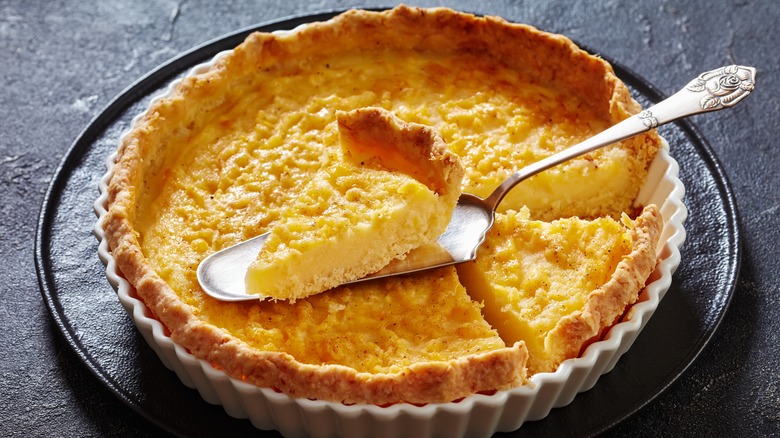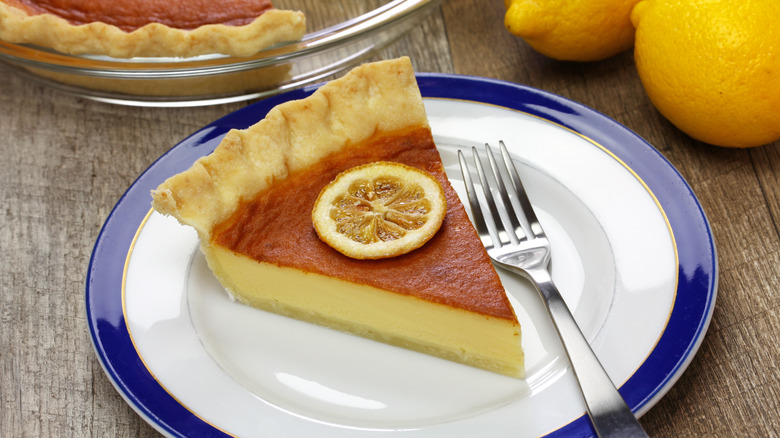What Is A Buttermilk Chess Pie, And What Does It Taste Like?
When you think about unique holiday desserts, what comes to mind? Probably a gently spiced pumpkin pie or a gooey apple pie — not necessarily a buttermilk chess pie. A Southern classic, especially around the holidays, this simple dessert is made from pantry staples and bakes up into a golden, creamy, and altogether satisfying pie that you can probably make right now, no shopping trip necessary. Chess pies are an example of a kind of timeless, nostalgic American dessert that is ingenious in its resourcefulness.
Any pie crust will do, whether it's your favorite pie crust or store-bought, so long as it's flaky and buttery. The pie is filled with a custard made with eggs, melted (but cooled) butter, buttermilk, and sugar thickened with either flour or cornstarch. When you remove it from the oven, it should have a slight wiggle, but to be sure it's cooked through, an instant-read thermometer should read 175 to 180 degrees Fahrenheit at the center of the pie. You need patience before digging in — if you cut into the pie before it's cooled, it won't have set, leading to a runny mess. You can store a buttermilk chess pie sealed in the refrigerator for up to four days.
This pie is for fans of crème brûlée
The sugar and the flour or cornstarch in the custard will caramelize in the oven, and the result is a pie with a top that's a delicious golden caramel color and slightly crunchy, like a giant crème brûlée. Underneath the crackly top is a custard that tastes like vanilla custard with a whisper of citrusy brightness. The buttermilk adds a tangy, unique flavor that balances the sweetness of the custard — some recipes call for 2 to 3 cups of sugar. A flaky, buttery, slightly salty pie crust also works to balance the sweetness of a buttermilk pie.
For chocolate lovers, you can add cocoa powder to the custard for a slightly sweet, deeply rich version of buttermilk chess pie that's almost like eating a brownie. The contrast between the chocolate's richness and the buttermilk's lightness is an ideal match. Both the lemon and chocolate versions wouldn't go amiss on a dessert table for the holidays. Luckily, you don't have to serve it warm. San Francisco baker Mary Denham (of pastry brand Blooms End) likes chess pie at room temperature or even chilled. For her chocolate chess pie, she amplifies the nuttiness of the chocolate with a whole wheat crust and tosses in some cacao nibs for crunch plus another dimension of cocoa flavor.
What are chess pies?
Buttermilk chess pie is considered a type of chess pie that is usually thickened with corn flour and whole milk instead of buttermilk and flour or cornstarch. Think of them along the same lines as other sugar-based pies like pecan pie and maple pie — custardy, almost too sweet, and deeply nostalgic. Some of these recipes came about because of a lack of anything fresh to bake with in hard times or between harvest seasons when stores of seasonal fruits ran low – otherwise called make-do pies.
Make-do, or desperation pies, resulted from the Great Depression in the 1930s when farmers and cooks had to make do with what was available or affordable. This meant making a vinegar pie as a stand-in for lemon meringue pie or a green tomato pie instead of an apple pie. Buttermilk and regular chess pies are made with things cooks had on hand that could be made into something appetizing. In times of need, the inventiveness of cooks knows no bounds — even Texas pecan pie was modified with oats. The trend continued into World War II due to food rationing. They're still popular regional favorites, like shoofly pie from Pennsylvania and Indiana sugar cream pie.


